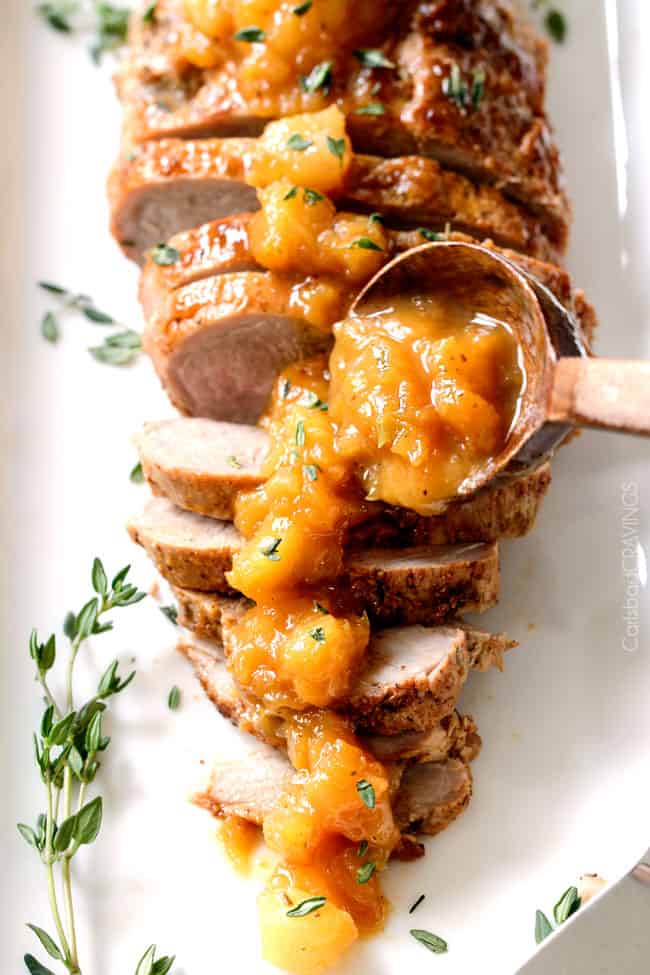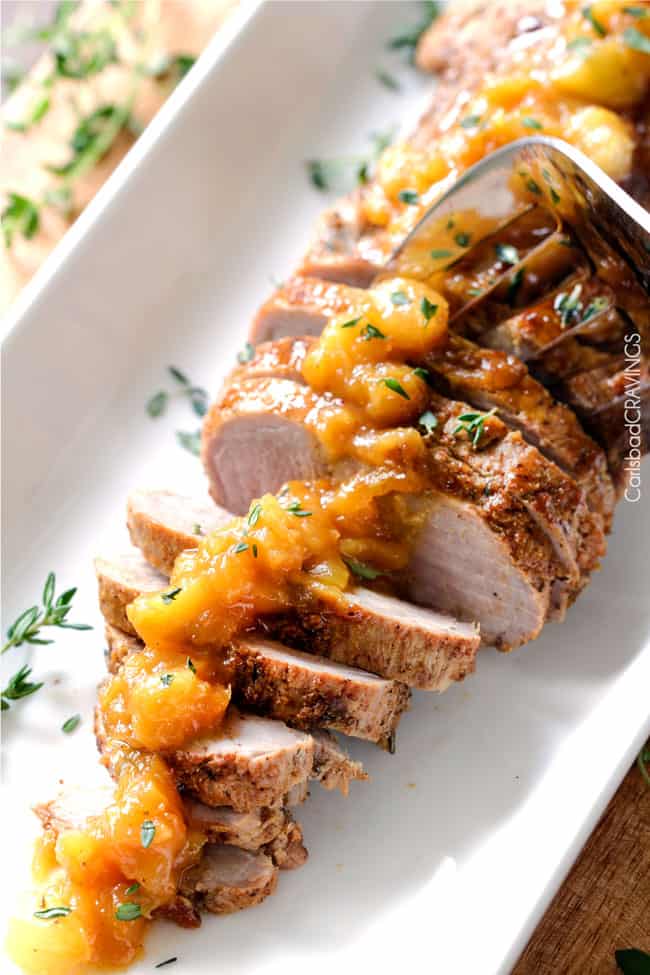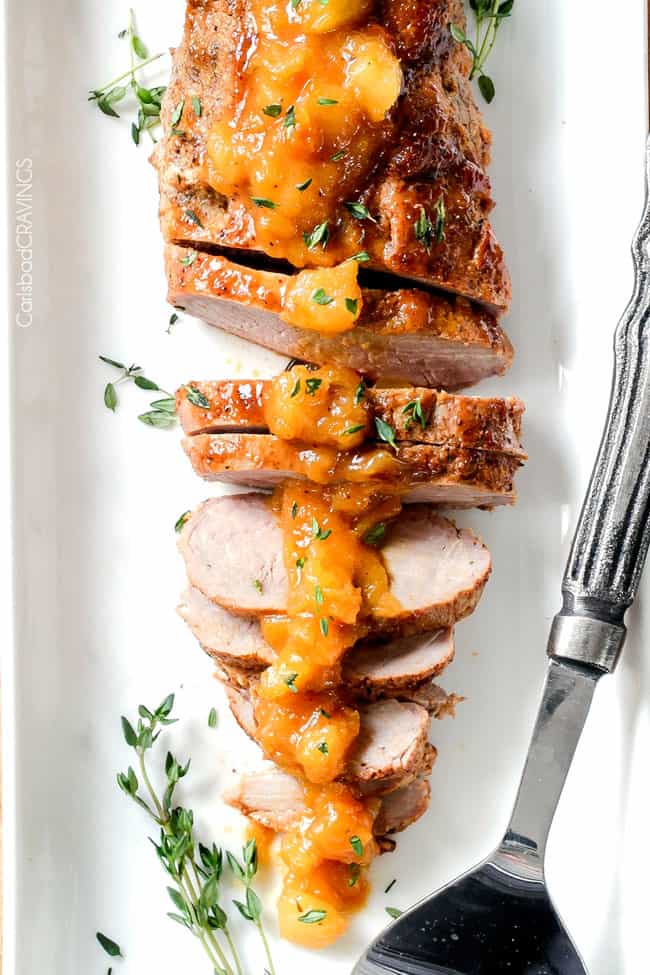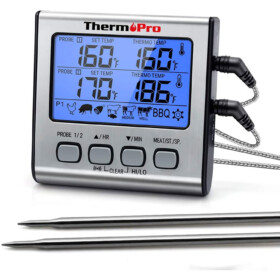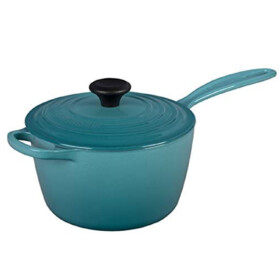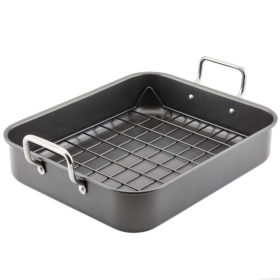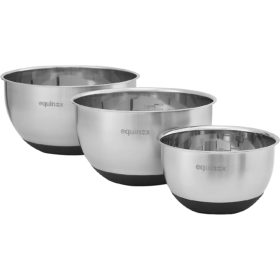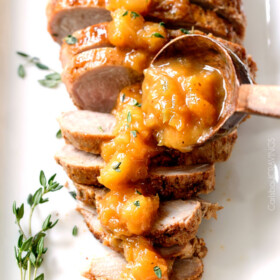PIN THIS RECIPE TO SAVE FOR LATER
Can you believe we have breezed passed the holidays, Super Bowl, and its time for Valentine’s Day already?! I love my Valentine with all my heart (cue sappy Our Love Story Post). He still hides packages of Sour Patch Kids for me to find when he goes out of town and I hide love notes for him to find in his luggage. Marrying my best friend has made for the best 13 years of my life. So when I asked him what I should write about Valentine’s he said, “Roses are Red, Violets are Blue, I hope you love this Pork Tenderloin too!” The man has skillz. But he speaks the truth, I think you will love this pork tenderloin recipe! And like I said in the intro, it is easier than you think! Even though the ingredient list is somewhat lengthy, most of them are spices and ingredients you already have in your pantry just waiting to transform everyday pork into this better-than-restaurant pork tenderloin.
Pork Tenderloin Recipe
The pork tenderloin is crazy moist and tender by first being placed in a water/salt/ brine for 20 minutes. Brining is like marinating meat in that it helps keep meat moist and tender by increasing the moisture capacity of the meat, resulting in melt in your mouth meat when cooked. The pork tenderloin is then rubbed in a flavorful but not too spicy Cajun rub, and then baked while being glazed with a tangy maple Dijon glaze. The remaining Maple Dijon Glaze gets simmered with crushed pineapple to create an out of this world sweet, tangy Pineapple Glaze/Sauce. I am already concocting other recipes based on this glaze because I am so in love with it and even more in love with the sweet, tangy slightly spicy combination that is this Cajun Pork Tenderloin with Pineapple Glaze. Roses are Red, Violets are Blue, I hope you love this Cajun Pork too! Now, I’m going to go into a lot of detail about how to make pork tenderloin, so you can stick along for the read, or skip directly to the pork tenderloin recipe.
About Pork Tenderloin
The tender in pork tenderloin. Pork Tenderloin lives up to its name – it is not only one of the most tender cuts of pork but of all proteins. Pork tenderloin is low in fat. Even with this lofty tender, juicy claim, pork tenderloin boasts fabulous flavor and is extremely low in fat. In fact, pork tenderloin is about as lean as a skinless chicken breasts – thus earning the name “the other white meat.”Pork tenderloin is easy to cook. Not only is it easy to prepare, pork tenderloin requires less than 30 minutes to cook. This quick cooking time is achieved because it cooks at a relatively high temperature so the meat doesn’t dry out. Pork tenderloin is versatile. It can be baked whole like in this pork tenderloin recipe or this baked recipe, it can be grilled whole, grilled in thin slices, cut into slices and pounded into cutlets, cut into cubes for kebabs or stir fries or even taco filling or cut into slices for satay.
WHAT IS THE DIFFERENCE BETWEEN A PORK LOIN AND PORK TENDERLOIN?
Pork Tenderloin is NOT pork loin – you cannot use them interchangeably. Here are the main differences:
Difference 1: Cut of Meat
Pork tenderloin: comes from the loin of the pig, which runs from the hip to the shoulder.Pork loin: comes from the back of a pig and is much wider and longer.
Difference 2: Size
Pork tenderloin: is thin and small, usually 1-2 pounds.Pork loin: can be cut to order anywhere from 3 to 5 pounds.
Difference 3: Texture and Flavor
Pork tenderloin: gets its name for a reason – it is one of the most tender cuts of pork because it comes from a muscle that doesn’t receives much, if any, exercise.Pork loin: is not naturally as tender and must be cooked much longer in order to become tender.
Difference 4: Cooking Method
Pork tenderloin: cooks quite quickly at higher temperatures, anywhere from 350 degrees to 425 degrees F.Pork loin: should be slow slow-roasting or grilled in order to become tender.
How much is a pork tenderloin?
You can purchase pork tenderloin in the meat section of your grocery store. I usually purchase mine at Costco which costs about $15 per package. It is pricier than chicken, but still a fabulous price to feed the entire family a restaurant worthy dinner.
How can I buy PORK TENDERLOIN?
2 per package: Pork Tenderloin is almost always sold in individual packages with two tenderloins per package. Each tenderloin weighs roughly 1-1 ½ pounds. Pork tenderloin is easy to consume, so my pork tenderloin recipes always use both pieces in one package. Prime pork tenderloin: If you have the chance, purchase pork tenderloin with “prime” on the label. Prime pork tenderloin is typically a little more expensive, but worth it. It is darker in color and boasts more marbling (AKA more flavor), a higher pH (lower acidity), which means even more tender, juicy, flavorful pork. Plain pork tenderloin: You will want to look for pork tenderloin that is NOT packaged in a rub or marinade, as we are going to brine and season the meat ourselves. This way, you not only control the flavor, but you can control the amount of salt and eliminate the oil in the marinade.
DO I NEED TO REMOVE THE SILVERSKIN BEFORE COOKING?
The silverskin is part of a sinew on one side of the pork tenderloin and looks like thin, silvery fat. You will want to remove it because it can become tough and chewy when cooked. Many packages of pork tenderloin will come pre-trimmed so you don’t need to worry about removing the silverskin before cooking in the oven. If your pork comes with the silverskin intact, however, you will need to remove it before roasting. How do I remove it? To remove the silverskin, slip a sharp knife in between the silver skin and the meat then cut it away until free. Take care to just remove the silverskin and not a big chunk of meat!
How to make the JUICIEST PORK TENDERLOIN
The best Pork Tenderloin recipes always start with a brine because brining = the JUICIEST pork tenderloin. You are probably familiar with brining a turkey, and the same concept holds true to brining pork tenderloin. Once you brine pork, you will never go back! Brining produces tender, juicy pork tenderoin every single time because it actually changes the molecular structure of the pork without having to prep and plan ahead with an overnight marinade. It also brings the pork to room temperature so it cooks more evenly instead of drying out the outside while waiting for the inside to cook. If you’ve never brined any protein before, don’t be intimidated – it literally takes 20 minutes! You actually can’t marinate it longer than that or the pork will become mealy – so literally 20 minutes! To brine pork, you will combine the following:
kosher saltwarm waterapple cider vinegarbrown sugarice cubespork
The brine tenderizes the pork tenderloin by changing its cell structure. The salt: 1) hydrates the cells of the muscle tissues via osmosis; 2) allows the cells to hold on to the water while they are cooked by breaking down the proteins so they can no longer contract when cooking. This means less water will be squeezed out and lost, resulting in juicier pork.
WHAT TEMPERATURE SHOULD I BAKE PORK TENDERLOIN?
Pork Tenderloin is a very lean cut of meat so it requires a relatively high oven baking temperature, about 400-425 degrees F. Lower temperatures require longer cooking times (up to an hour) which dry out the pork. By cooking at a higher temperature, the meat is cooked through before it has time to dry out.
HOW LONG TO COOK PORK TENDERLOIN?
The cooking time for pork tenderloin will depend on:
the actual thickness/size of porkif the pork has been seareddesired doneness/internal temperatureactual oven temperature
That being said, typically pork tenderloin requires 25-30 minutes at 425 degrees to reach 145 degrees F at the thickest part of the pork.
WHAT SHOULD PORK TENDERLOIN LOOK LIKE WHEN DONE?
According to USDA guidelines, pork tenderloin is safe to consume when a thermometer inserted into the thickest part of the meat registers 145 degrees F. This means it will be slightly pink inside which is OKAY. This 145-degrees temperature is 15 degrees less than the old standards of 160 degrees F which would mean the pork would be completely cooked through without any pink. The research shows, however, that 145 degrees F is the same safety-wise as cooking pork to 160 degrees F AND yields much more tender pork. Your pork will increase anywhere from 5-10 degrees in temperature as it rests, so I like to take mine out as soon as it hits 145 degrees for the juiciest pork. If you overcook your pork tenderloin, it will transform from fork tender to dry and chewy. This is what your pork will look like with the allotted 5-minute resting time:
take pork out at 145 F, will rise to 150 F – slices will be somewhat pink and moisttake pork out at 150 F, will rise to 155 F – slices will be a little pink and moisttake pork out at 160 F, will rise to 165 F – slices will not be pink but still should be relatively moist
HOW TO COOK PORK TENDERLOIN
Cooking pork tenderloin is very simple even though it looks like a few steps:
Brine pork tenderloin: Mix the kosher salt with warm water in order to dissolve the salt, then mix in the cider vinegar, brown sugar and ice cubes. Add the pork and brine for 20 minutes. Dry pork before seasoning: When your pork is done brining, rinse in cool water and pat dry with paper towels. It is important the pork is quite dry after brining so the rub will stick to the pork.Season pork with wet rub: Whisk together the Cajun Rub spices in a small bowl. Remove 1 teaspoon for the Glaze. Whisk together remaining rub spices with 2 tablespoons olive oil. Rub the pork all over with this Wet Rub. Make Glaze. Whisk together all of the Glaze ingredients EXCEPT for crushed pineapple. Remove ¼ cup Glaze for basting and set aside (“Basting Glaze”). The rest of the Glaze will be simmered with crushed pineapple to become the Pineapple Glaze.Sear pork tenderloin: Heat vegetable oil over medium-high heat and swirl the pan to evenly coat the bottom of oil. Wait until the oil is very hot before adding pork tenderloin. Sear each side until browned, approximately 1-2 minutes per side. Baste pork tenderloin: Place tenderloin on rack in shallow roasting pan or on a lightly greased rack placed on a baking sheet and baste with half of the Basting Glaze. Bake in oven: Bake at 425 degrees F for 25-30 minutes or until pork registers between 145- and 150-degrees F (63 and 65 degrees C) at the thickest part of the tenderloin. This means the pork will be juicy and slightly pink in the middle. Do NOT overbake or your pork will not be as moist.Rest pork: Let pork tenderloin rest 10 minutes before slicing. This allows time for the redistribution and reabsorption of the juices throughout the pork tenderloin. Finish with glaze: Meanwhile, heat Pineapple Glaze in the small saucepan just until warmed and serve over sliced tenderloin.
TIPS FOR EASY PORK TENDERLOIN RECIPE
Making pork tenderloin is pretty straight forward, but here are a few tips and tricks for the best pork tenderloin recipe every time:
Fully dissolve salt. When making the brine, whisk the kosher salt in the warm water until it is dissolved before adding the rest of the ingredients.Don’t brine too long. Only brine pork tenderloin for 20 minutes – no longer! – otherwise the pork will become mealy.Rinse pork from brine. Rinse your pork tenderloin thoroughly after brining to remove excess salt otherwise it will taste too salty. Do NOT substitute the kosher salt with equal amounts table salt.Sear before baking: Many readers wonder if they really have to sear their pork tenderloin before baking and the answer is YES. Searing the pork creates the Maillard reaction resulting in rich, deep, complex flavor. Equally important, it locks in the juices which prevents the surface of the tenderloin from becoming dehydrated when cooked at high heat.Sear in batches. If you cannot sear both tenderloins without them touching, then you will want to sear in two batches. Sear the tenderloin until golden on all sides. Use vegetable oil. Don’t substitute olive oil for vegetable oil in searing because we need an oil with a high smoking point. Use a heavy bottom pan. A cast iron skillet is ideal for searing but if you don’t have one, you can use a QUALITY nonstick pan, it will just take a little longer to brown. If your nonstick pan is too hot or not quality, it can ruin the nonstick surface. Baste: The pork tenderloin is basted with a glaze containing both apple cider vinegar and lemon juice. The acid from these ingredients breaks down the meat while it roasts, making it significantly more tender.Use a meat thermometer. Pork tenderloin is lean and therefore can dry out very easily if overcooked so it is important to use a meat thermometer to achieve the correct temperature. They are a small investment and come in handy ALL the time and eliminate all of the guess-work. Last time I baked this pork tenderloin recipe, one of my tenderloins was done a full 5 minutes before the other, which I wouldn’t have know without an instant read thermometer. Rest before slicing: Let the pork tenderloin rest the full 10 minutes before slicing otherwise you will loose valuable juices.Slice across the grain: Slice the pork tenderloin across the grain. You want to cut perpendicular to the muscle fibers so they become as short as possible, as opposed to parallel which will result in long muscle fibers and chewy, rubbery meat. You can either slice in ½” slices or my husband loves super thin slices.
WHAT SIDES ARE BEST WITH BAKED PORK TENDERLOIN?
This Pork Tenderloin recipe pairs beautifully with any number of sides from simple rice and a big green salad to more elaborate fair. Here are a few of my favorites:
Salads: Wedge Salad, Spinach Berry Salad, Strawberry Avocado Broccoli Salad, Creamy Bacon Pea Pasta Salad, Cucumber Tomato Salad, Strawberry Salad, Corn Salad Fruit Salads: Perfect Fruit Salad, Creamy Grape Salad, Pina Colada Fruit Salad, Berry Salad in Honey Mascarpone DressingBreads: Award Winning Cornbread, Perfect Dinner Rolls, Buttery BreadsticksPotatoes: Company Mashed Potatoes, Slow Cooker Mashed Potatoes, Smashed Potatoes, Twice Baked Potatoes, Au Gratin Potatoes, Roasted Pesto PotatoesVeggies: Roasted Broccoli, Roasted Cauliflower, Roasted Carrots, Saluted Brussels Sprouts, Glazed Carrots, Brown Butter Asparagus or Parmesan Asparagus
HOW TO USE LEFTOVER PORK TENDERLOIN
Due to the tenderness of pork tenderloin, it makes fabulous leftovers. It is delicious plain, on sandwiches, in wraps, rice, eggs, hash browns, pastas/ramen, pasta salads, rice, or soups.
HOW LONG IS LEFTOVER PORK GOOD FOR?
Leftover pork tenderloin should be stored in an airtight container in the refrigerator. When properly stored, pork is good up to 5 days.
LOOKING FOR MORE PORK RECIPES?
Slow Cooker Asian Caramel Pulled PorkBrown Sugar Glazed HamSheet Pan Chili Dijon Pork Tenderloin with Green Beans and PotatoChipotle Sweet Pulled PorkRoasted Pork with Blackberry Hoisin GlazeSlow Cooker Pulled Pork Sloppy JoesSlow Cooker Pork CarnitasMaple Cider Ham
Want to try this Pork Tenderloin Recipe?
Pin it to your Pork, dinner or holiday Board to SAVE for later!
Find me on Pinterest for more great recipes! I am always pinning :)!
©Carlsbad Cravings by CarlsbadCravings.com Carlsbad Cravings Original Tag @CarlsbadCravings and Use #CarlsbadCravngs Leave a Review, I Always Love Hearing From You!

